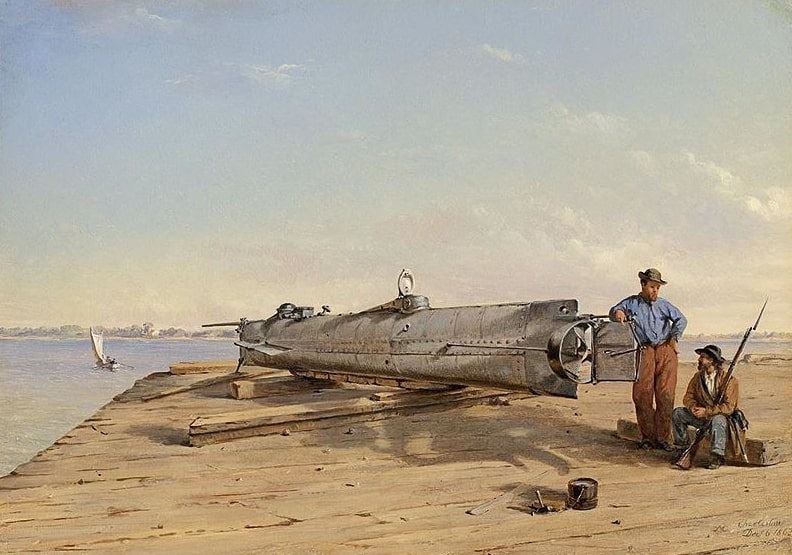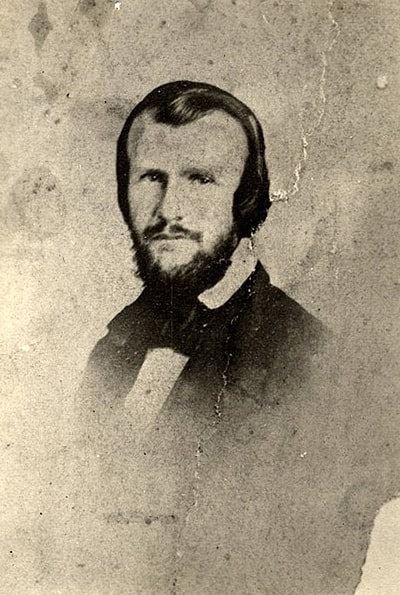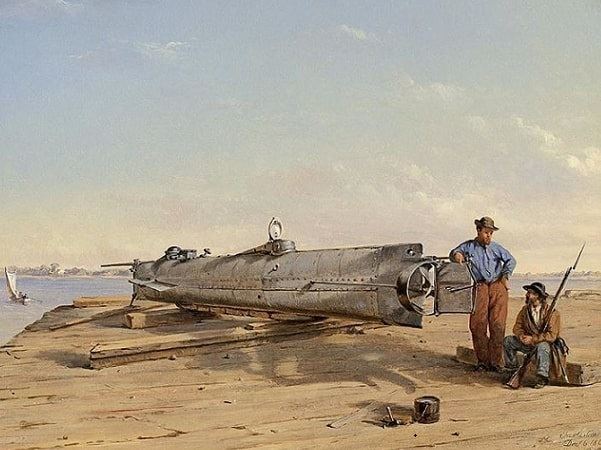On 17 February 1864, the Confederate submarine H.L. Hunley began a new era in naval warfare when it sank the Union warship Housatonic, becoming the first submarine in history to sink an enemy ship.

The painter of the above illustration, Conrad Wise Chapman, wrote an interesting note about this painting:
“The inventor of this boat, a man named Hunley, can be seen; also a sentinel. This boat, it was at first thought would be very effective; twice it went out on its mission of destruction, but on both occasions returned with all the crew dead. After this had happened the second time, someone painted on it the word ‘coffin.’ There was just room enough in it for eight men, one in front of the other, with no possibility of anyone sitting straight. The third time it started out, it never came back, nor was anything ever heard from it, but as one of the United States men-of-war in the harbor (USS Housatonic) was sunk at about the same time, the supposition was that they both went to the bottom together. Other objects to be seen in the picture are, Sullivan’s Island, and a Dispatch boat.”
The final newspaper article reproduced at the end of this blog article has more on this painting.
At the time it was sunk, the Housatonic was engaged in the Union blockade of Charleston Harbor, South Carolina, and its destruction was a hopeful sign for that city’s residents. But there were two reasons why celebrations of this historic naval victory were muted – for one, the H.L. Hunley mysteriously sank shortly after sinking the Housatonic, with the loss of all eight of its crewmen.
For another, Horace Lawson Hunley, who financed and helped invent the historic submarine, was not around to celebrate the sinking of the Housatonic. He had died four months previously, on 15 October 1863, along with all seven members of the crew, while conducting a training run with the submarine. It was subsequently named in his honor.

The H.L. Hunley was the third submarine Hunley had built, along with his partners James McClintock and Baxter Watson. It was almost 40 feet long, powered by a hand-cranked propeller, and carried one “torpedo” (a bomb with a barb, attached to a long spar, which was rammed into an enemy ship’s hull and detonated after the submarine had backed away to a safe distance).
Although the H.L. Hunley did successfully sink an enemy ship, it had a deadly history for the men who operated it. Twice it sank during training exercises, with a total loss of 13 men, but both times was salvaged and outfitted again. Then, of course, the one time it did attack the enemy, it sank for the third – and final – time, with the loss of an additional eight men.
The following four Southern newspaper articles are about the H.L. Hunley. The first article was published by the Mobile Register (the submarine had been built in Mobile, Alabama) and reprinted by the Charleston Mercury (Charleston, South Carolina) on the front page of its 16 November 1863, issue. Entitled “A Hero Fallen,” the article concluded with this tribute to Horace L. Hunley:
Here is a transcription of this part of the article:
His last unselfish, patriotic and self-sacrificing act was characteristic of his whole life. He lived as he died, wholly for the welfare and happiness of others. Hard, therefore, the task of him who, in expressionless words, seeks to portray the feelings of a heart filled with love and grief and gratitude for what now is but a name and an intangible memory. Oh, Horace, and those who perished at your side,
“ – Holy be your memories!
Blessed and glorious now and evermore
Be your heroic names!”
Here is a transcription of this article:
TO THE GRATEFUL AND GENEROUS. – Among the hosts of patriots who have given their lives to the cause of their country, there are some, who, in an especial manner, have richly earned the substantial gratitude of this community. Prominent amongst these latter are the devoted men who lately perished in our harbor in the furtherance of the work conceived and so nobly begun by the gallant HUNLEY. We call attention to the following note:
HEADQUARTERS,
DEPARTMENT OF SO. CA., GA. AND FLA.,
Charleston, S.C., Nov. 16, 1863.To the editors of the Mercury: Five of the men drowned in this harbor with Captain Hunley, several weeks ago, were mechanics of the city of Mobile, who have left families in destitute circumstances, having been dependent for support on the wages of the men now taken from them. These families are commended to the attention of the liberal gentlemen of Charleston, as objects worthy of a judicious and substantial charity.
THOMAS JORDAN, Chief of Staff.
Here is a transcription of this notice:
WE HAVE RECEIVED from Captain CHISOLM, his check for $250, for the benefit of the families of the five men who lost their lives in the submarine boat with Captain HUNLEY.
This final article, published 34 years after the Civil War ended, reflected Southern pride in the historic achievement of the Confederate submarine, declaring it was “a boat whose creation showed the power of the Southern mind to invent.” This article was a fundraising appeal to the regents of the Confederate Memorial Museum to purchase a collection of paintings:
“There are now on exhibition in this city a series of thirty-one (31) oil paintings made at Charleston, S.C., between the dates of September 16, 1863, and March 16, 1864, by Mr. Conrad Wise Chapman, who left his studio in Rome to take part with us in our great struggle. The paintings are of extraordinary interest, not only as works of art, but because they represent vividly the actual daily life and appearance of the men, batteries and boats who successfully defended Charleston against every attack made on it from the water front.”
The article included a description of the painting shown at the beginning of this blog article.
Here is a transcription of this part of the article:
These pictures would have great value for any museum as works of art, but for the south – for this museum, which holds the memories and relics of the entire Confederacy, they are priceless. They were executed on the spot, often under heavy fire; and were painted under the strong impetus of personal enthusiasm by the young artist, who was detailed for the specific purpose. They exist today without parallel, and, above all, they prove the fact (too often overlooked) that the Confederacy achieved remarkable results in the field of military service and invention.
To describe them as they deserve will be impossible at this time; only a few striking points can be mentioned in this brief letter:
Picture No. 14 represents the submarine torpedo boat ‘H. L. Hunley.’ This was the first submarine boat ever constructed. She sank the ‘Keokuk’ [the Housatonic – ed.], and was herself lost, with all her crew. We have, therefore, the only authentic picture of a boat whose creation showed the power of the southern mind to invent, and whose end proved once more the courage of the Confederate heart to dare any peril for the cause for which we fought.
Note: An online collection of newspapers, such as GenealogyBank’s Historical Newspaper Archives, is not only a great way to learn about the lives of your ancestors – the old newspaper articles also help you understand American history and the times your ancestors lived in, and the news they talked about and read in their local papers. Did any of your ancestors serve in the Civil War? Please share your stories with us in the comments section.
Explore over 330 years of newspapers and historical records in GenealogyBank. Discover your family story! Start a 7-Day Free Trial
Related Articles:
